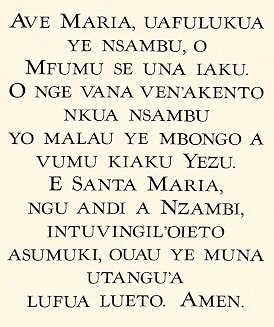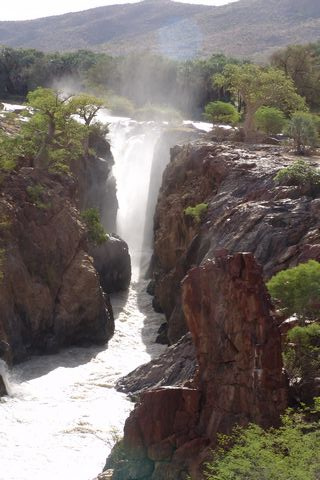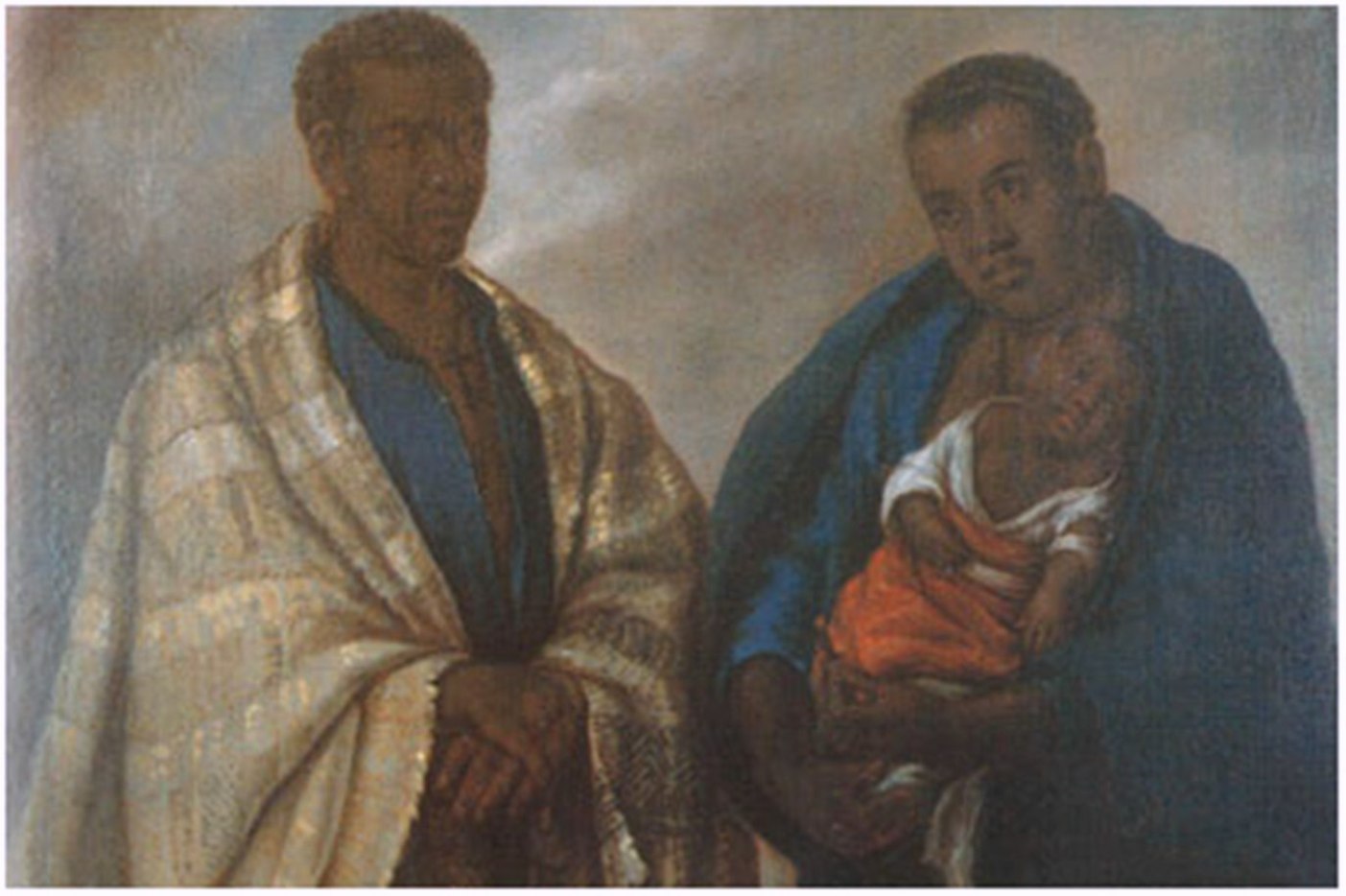|
Engolo
Engolo or NGolo (Kikongo word meaning strength, power) is a performance of ritual combat by various ethnic groups around the Cunene River in southern Angola. The style of fighting involves various kicks, dodges, and leg sweeps, with an emphasis on inverted positions, i.e. with one or more hands on the ground. The first mention of Engolo in literature was made by Albano Neves e Sousa in a set of drawings demonstrating various techniques and their similarities to the Afro-Brazilian art form of Capoeira in the 1960s. Engolo is one of several African martial arts of the African Diaspora in the Americas. Neves e Sousa described Engolo as part of a rite of passage, Omuhelo, between young boys vying for a bride in the contest, and whose techniques derived from the peculiar way in which Zebras fight amongst themselves. Research carried out by Dr. TJ Desch Obi finds that Engolo itself is not strictly performed for any one ritual, but as an element in various public and private performance ... [...More Info...] [...Related Items...] OR: [Wikipedia] [Google] [Baidu] |
Capoeira
Capoeira () is an Afro-Brazilian martial art that combines elements of dance, acrobatics, music and spirituality. Born of the melting pot of enslaved Africans, Indigenous Brazilians and Portuguese influences at the beginning of the 16th century, capoeira is a constantly evolving art form. It is known for its acrobatic and complex maneuvers, often involving hands on the ground and inverted kicks. It emphasizes flowing movements rather than fixed stances; the ''ginga'', a rocking step, is usually the focal point of the technique. Although debated, the most widely accepted origin of the word ''capoeira'' comes from the Tupi words ''ka'a'' ("forest") ''paũ'' ("round"), referring to the areas of low vegetation in the Brazilian interior where fugitive slaves would hide. A practitioner of the art is called a capoeirista (). Though often said to be a martial art disguised as a dance, capoeira served not only as a form of self defence, but also as a way to maintain spirituality and cu ... [...More Info...] [...Related Items...] OR: [Wikipedia] [Google] [Baidu] |
Kikongo
Kongo or Kikongo is one of the Bantu languages spoken by the Kongo people living in the Democratic Republic of the Congo, the Republic of the Congo, Gabon and Angola. It is a tonal language. It was spoken by many of those who were taken from the region and sold as slaves in the Americas. For this reason, while Kongo still is spoken in the above-mentioned countries, creolized forms of the language are found in ritual speech of Afro-American religions, especially in Brazil, Cuba, Puerto Rico, the Dominican Republic and Haiti. It is also one of the sources of the Gullah language and the Palenquero creole in Colombia. The vast majority of present-day speakers live in Africa. There are roughly seven million native speakers of Kongo, with perhaps two million more who use it as a second language. Geographic distribution Kongo was the language of the Kingdom of Kongo prior to the creation of Angola by the Portuguese Crown in 1575 and the Berlin Conference (1884-1885) that balkanized ... [...More Info...] [...Related Items...] OR: [Wikipedia] [Google] [Baidu] |
Ritual Combat
__NOTOC__ Ritual warfare (sometimes called endemic warfare) is a state of continual or frequent warfare, such as is found in some tribal societies (but is not limited to tribal societies). Description Ritual fighting (or ritual battle or ritual warfare) permits the display of courage, masculinity and the expression of emotion while resulting in relatively few wounds and even fewer deaths. Thus such a practice can be viewed as a form of conflict-resolution and/or as a psycho-social exercise. Native Americans often engaged in this activity, but the frequency of warfare in most hunter-gatherer cultures is a matter of dispute. Examples Warfare is known to every tribal society, but some societies develop a particular emphasis of warrior culture (such as the Nuer of South Sudan, the Māori of New Zealand, the Dugum Dani of Papua, the Yanomami (dubbed "the Fierce People") of the Amazon. The culture of inter-tribal warfare has long been present in New Guinea. Communal societi ... [...More Info...] [...Related Items...] OR: [Wikipedia] [Google] [Baidu] |
Cunene River
The Cunene (Portuguese spelling) or Kunene (common Namibian spelling) is a river in Southern Africa. It flows from the Angola highlands south to the border with Namibia. It then flows west along the border until it reaches the Atlantic Ocean. It is one of the few perennial rivers in the region. It is about long, with a drainage basin in area. Its mean annual discharge is 174 m3/s (6,145 cfs) at its mouth. The Epupa Falls lie on the river. Olushandja Dam dams a tributary of the river, the Etaka, and helps provide the Ruacana Power Station with water. Dam controversies The Namibian government proposed in the late 1990s to build the Epupa Dam, a controversial hydroelectric dam on the Cunene. In 2012 the Governments of Namibia and Angola announced plans to jointly build the Orokawe dam in the Baynes Mountains. According to the indigenous Himba who would have been most affected by the construction of the dam, the dam threatens the local ecosystem and therefore the economic ... [...More Info...] [...Related Items...] OR: [Wikipedia] [Google] [Baidu] |
Angola
, national_anthem = "Angola Avante"() , image_map = , map_caption = , capital = Luanda , religion = , religion_year = 2020 , religion_ref = , coordinates = , largest_city = capital , official_languages = Portuguese , languages2_type = National languages , languages2 = , ethnic_groups = , ethnic_groups_ref = , ethnic_groups_year = 2000 , demonym = , government_type = Unitary dominant-party presidential republic , leader_title1 = President , leader_name1 = João Lourenço , leader_title2 = Vice President , leader_name2 = Esperança da CostaInvestidura do Pre ... [...More Info...] [...Related Items...] OR: [Wikipedia] [Google] [Baidu] |
Albano Neves E Sousa
Albano may refer to: Places * Albano (river), Lombardy, Italy * Lake Albano, Italy * Roman Catholic Suburbicarian Diocese of Albano, near Rome * Albano (Stockholm), an area in Stockholm, Sweden * Albano Lacus, a hydrocarbon lake on Saturn's largest moon, Titan People * Albano (name), a list of people with the given name or surname * Albano (footballer, born 1922), Albano Narciso Pereira (1922–1990), Portuguese football forward * Albano (footballer, born 1997), Albano Sehn Neto, Brazilian football midfielder * Albanus Albano, a pen name of Vaso Pasha (1825-1892), Albanian writer and poet and Governor General of Lebanon Other uses * Albano buoy system, used to mark lanes for rowing and canoeing events * an alternative name for the Italian wine grape Trebbiano * a synonym for the Italian wine grape Albana See also *Albano Laziale, a ''comune'' in the province of Rome, Italy *Albano di Lucania, a ''comune'' in the province of Potenza, Italy *Albano Sant'Alessandro, a ''co ... [...More Info...] [...Related Items...] OR: [Wikipedia] [Google] [Baidu] |
Martial Arts
Martial arts are codified systems and traditions of combat practiced for a number of reasons such as self-defense; military and law enforcement applications; combat sport, competition; physical, mental, and spiritual development; entertainment; and the preservation of a nation's intangible cultural heritage. Etymology According to Paul Bowman, the term ''martial arts'' was popularized by mainstream popular culture during the 1960s to 1970s, notably by Hong Kong martial arts films (most famously those of Bruce Lee) during the so-called "chopsocky" wave of the early 1970s. According to John Clements, the term '':wikt:martial art, martial arts'' itself is derived from an older Latin (language), Latin term meaning "arts of Mars (mythology), Mars", the Roman mythology, Roman god of war, and was used to refer to the combat systems of Europe (European martial arts) as early as the 1550s. The term martial science, or martial sciences, was commonly used to refer to the fighting arts of E ... [...More Info...] [...Related Items...] OR: [Wikipedia] [Google] [Baidu] |
African Diaspora
The African diaspora is the worldwide collection of communities descended from native Africans or people from Africa, predominantly in the Americas. The term most commonly refers to the descendants of the West and Central Africans who were enslaved and shipped to the Americas via the Atlantic slave trade between the 16th and 19th centuries, with their largest populations in the United States, Brazil and Haiti. However, the term can also be used to refer to the descendants of North Africans who immigrated to other parts of the world. Some scholars identify "four circulatory phases" of this migration out of Africa. The phrase ''African diaspora'' gradually entered common usage at the turn of the 21st century. The term ''diaspora'' originates from the Greek (''diaspora'', literally "scattering") which gained popularity in English in reference to the Jewish diaspora before being more broadly applied to other populations. Less commonly, the term has been used in scholarship to ... [...More Info...] [...Related Items...] OR: [Wikipedia] [Google] [Baidu] |
Kalunga
The Kalungas are Brazilians that descend from people who freed themselves from slavery, and lived in remote settlements in Goiás state, Brazil. The Kalungas are one group of Quilombola, or people of African origin who live in hinterland settlements founded during the period of escaped slaves. The Kalunga communities of Goiás have existed for approximately 250 years, and first came back into contact with researchers and the federal government in the 1960s. Most of the approximately 5,000 Kalungas, who are of mixed African and indigenous ancestry, live in very poor conditions. In Zambia, the name Kalunga is of Bantu origin and means "Hunter or accurate hunter". All of the area occupied by the Kalungas was officially recognized by the state government in 1991 as a Historical Site and the Kalunga are preserved as Patrimônio Cultural Kalunga. The Kalungas settled in the mountains on both sides of the Paraná River, on slopes and in valleys, called Vãos. Today they occupy ... [...More Info...] [...Related Items...] OR: [Wikipedia] [Google] [Baidu] |
Kalunga Line
The Kalunga line is a watery boundary between the world of the living and the dead in religious traditions of the Congo Congo or The Congo may refer to either of two countries that border the Congo River in central Africa: * Democratic Republic of the Congo, the larger country to the southeast, capital Kinshasa, formerly known as Zaire, sometimes referred to a ... region. The word Kalunga is Kikongo for "threshold between worlds". The Kalunga line is often associated with bodies of water, with the Atlantic Ocean being prominent. They believed the soul after death traveled the path of the sun as it set in the west. The enslaved believed they were being taken to the land of the dead, never to return. Thus the Kalunga line became known as a line under the Atlantic Ocean where the living became the dead and the only way back to life was to recross the line. Some religions today still make reference to the Kalunga Line believing that the soul of an African-American travels back ... [...More Info...] [...Related Items...] OR: [Wikipedia] [Google] [Baidu] |




.jpg)

